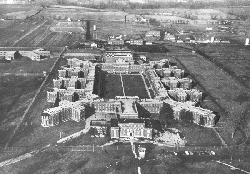Lima State Hospital
| Lima State Hospital | |
|---|---|
 | |
| Established | 1905 |
| Construction Began | 1908 |
| Opened | 1915 |
| Closed | 2004 |
| Current Status | Closed |
| Building Style | Pavilion Plan |
| Location | Lima, OH |
| Alternate Names |
|
History
Situated on 628 acres (2.54 km²) three miles (5 km) north of downtown Lima, the hospital was constructed between 1908 and 1915. Built at a cost of $2.1 million, it was the largest poured-concrete structure in the country until superseded by the Pentagon. Its walls are at least 14 inches thick, with steel reinforcement going right down to bedrock.
In 1915 Lima State Hospital began receiving its first patients. Built to house specifically those found guilty of crimes while insane or otherwise too dangerous for the other state run psychiatric institutions. 1953 brought the opening of the Ascherman building, a satellite of the state hospital so the state hospital could start housing regular patients.
For much of its history, Lima State Hospital functioned largely as a warehouse. Patients sometimes staged dramatic protests against the conditions of their confinement, and frequently escaped (more than 300 escapes by 1978). Conditions improved significantly after 1974 as a result of a class-action lawsuit filed on behalf of the patients. In a landmark ruling, U.S. District Judge Nicholas J. Walinski spelled out detailed requirements for assuring each patient’s rights to “dignity, privacy and human care.” In its last years, the state hospital was used for the filming of a made-for-television movie about the Attica Prison riots in New York.
In 1982 the building was turned over to the Ohio Department of Corrections and became a medium-security prison, the Lima Correctional Institution. The prison closed in 2004, though a smaller prison on the site, the Allen Correctional Institution, remains.
News Article
With 1,400 patients and 700 staff members on a 600-acre state facility, Lima was home to many individuals deemed "criminally insane" after the Lima State Hospital was built in 1907 on West Street. With the changing times, however, it died down in later decades. And, according to a physician researching and writing books about "lunatic asylums," it eventually closed as part of a national trend that ended the era of such homes for the mentally ill. Though the building still stands as the Oakwood Correctional Facility, south of Bluelick Road, local historians said, it's nowhere near its heyday. During a program Sunday afternoon at the Allen County Museum, Dr. George W. Paulson, of The Ohio State University Medical Center, Columbus, spoke about the Lima facility and the state hospital in Columbus. He discussed the history of the evolution of the mental health system from the late 19th century through the 20th century, based on research for his latest book: "Hilltop, a Hospital and a Sanctuary for Healing," which is co-authored by Dr. Marion Sherman. The Allen County Historical Society presented the program free to the public. "A lot of people in the community might be interested in this," said Patricia Smith, director of the Allen County Museum. "The facility here was unique because it was for the ‘criminally insane.' They were deemed dangerous." Paulson, 78, is emeritus professor of neurology at OSU and is the founder and former chairman of the department of neurology, and former chief of staff of University Hospitals. With more than 250 articles and six books, Paulson said his interest in mental health is in part inspired by his past working in such facilities. "What happened here to the state facility happened all over the country," Paulson said. "Patients went from the back wards to the back alleys, and streets. Some are in prison. ... There's a difference in the way they are treated now. There's much better therapy and research ... but they treat the mentally ill differently." Paulson said deinstitutionalization of mental health hospitals meant the demolition of many facilities when the trend commenced after 1950.[1]
Images of Lima State Hospital
Main Image Gallery: Lima State Hospital
Cemetery
A 2 acre lot contains the remains of 502 patients remains.
References
- ↑ LIMA - There was a time when the "worst" of the "worst" were sent to this city by Brian J. Evans http://www.limaohio.com/news/state_24572___article.html/facility_hospital.html


